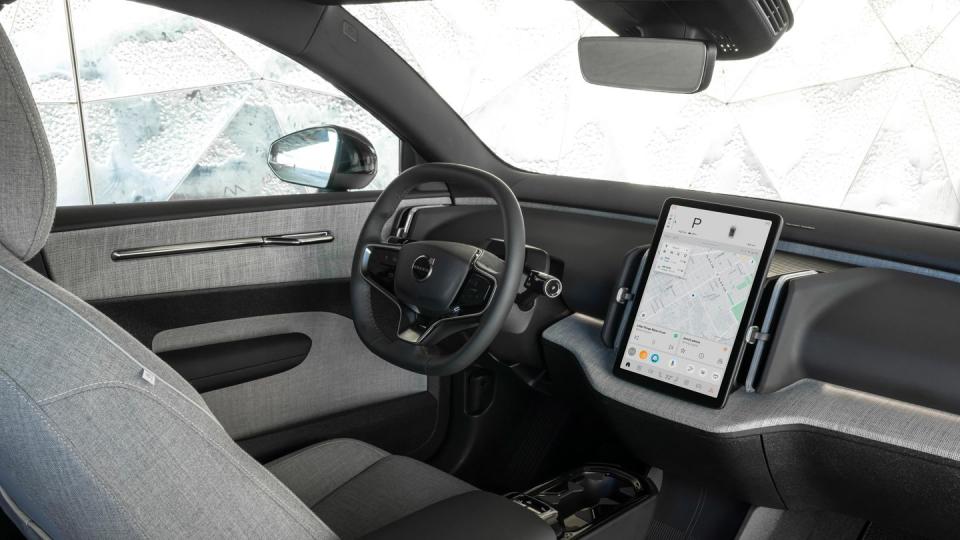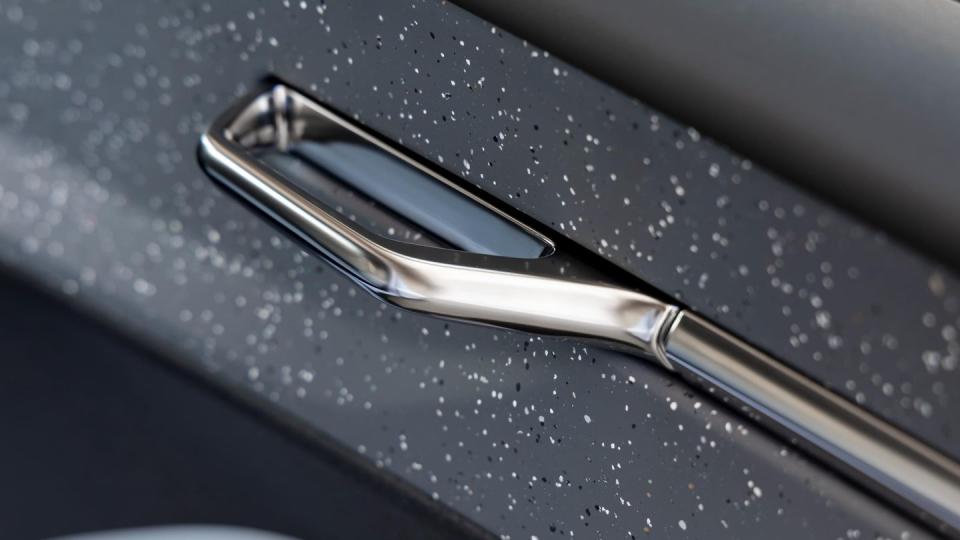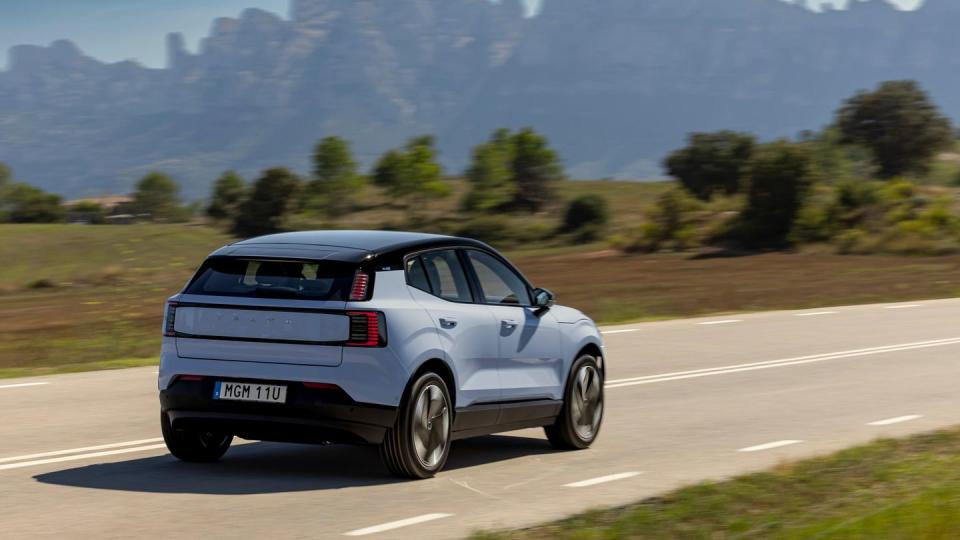2025 Volvo EX30 Is Affordable, but Not Luxurious

From a performance standpoint, Volvo’s new EX30 crossover EV is capable and fun to drive, with plenty of thrust from a standstill and at highway speed, with either rear- or AWD.
But inside the EX30, Volvo opted for a bare-bones interior with too much hard, cheap plastic in an aggressive bid to keep the sticker price down.
Shoppers might not mind the interior when they see the $36,245 starting price, directly in line with the all-new, midsize Chevrolet Equinox EV.
The all-electric EX30 compact crossover shows Volvo at a crossroads. This cute ute represents a vital step toward Volvo’s target to sell nothing but electric vehicles by 2030 and—even sooner—to achieve 50% EV sales by 2025.
And after generations of vehicles built on front-wheel-drive architectures, the capable, all-new EX30 starts with rear-wheel drive (and 275 miles of range) but can deploy optional all-wheel drive with an extra motor mounted up front, for 265 miles of range. The same configuration applies to the larger seven-passenger EX90 electric SUV, which initially was supposed to launch before the EX30 but was delayed.
Perhaps more than anything else, the EX30 finds Volvo reinterpreting what constitutes luxury. The Swedes have generally taken a progressive approach to upscale interiors, emphasizing Scandinavian artsy design, natural materials, airiness, and functionality, while positioning Volvo as a European luxury brand.
Sitting in the EX30 for the first time, one certainly finds the cabin progressive and functional but hardly luxurious. You won’t find any of the beautiful matte-finish blonde oak veneer curved upward from the center console, like in the earlier S60. The Orrefors crystal shifter that gave the XC90 an elegant look and feel has been replaced by a simple black plastic column shifter in the EX30.
But before detailing this stripped-down interior with a cramped second row, let’s cover the drive impressions and powertrain.
A 69-kWh NMC battery produces 268 hp and 253 lb-ft of torque with the single rear motor (good for a 0-to-60 mph sprint in 5.1 seconds), while the same battery with a second motor up front generates 422 hp and 400 lb-ft for a 0-to-60 time of 3.4 seconds.

By today’s EV standards, the EX30 is light, weighing in at 3858 pounds with one motor or 4140 pounds with two. It DC fast charges at a rate of 153 kW in 26.5 minutes, from 10% to 80%.
From a performance standpoint, the EX30 is capable and fun to drive, with plenty of thrust from a standstill and at highway speed, with either rear- or AWD. It could be argued the single-motor EX30 handles better because the AWD variant adds 220 pounds up front and a bit of torque steer.
As for energy efficiency, our test drive in a single-motor EX30 achieved a competitive 3.9 miles per kWh, while the twin-motor was less impressive, at 3.0 miles per kWh. There’s just one setting to turn on one-pedal driving, but Volvo is considering an OTA update to add a second, less abrupt setting for regenerative braking.
Interior Is Innovative, but Not Elegant
Battery-electric vehicles are launching so frequently that they are starting to blur together in terms of dynamic performance: They’re all quiet, smooth, and torquey, with a low center of gravity, which makes range, styling, and interior features the most important differentiators when shopping across brands.
In the case of the EX30, Volvo opted for a bare-bones interior with too much hard, cheap plastic in an aggressive bid to keep the sticker price down.
To be clear, there are interesting and innovative materials inside the EX30—pegged to recycling, repurposing, and sustainability—like the ground-up denim scraps used from blue jean manufacturing to weave the base Indigo seat fabric, or the pine resin and polymer used to make Nordico as a leather replacement on another trim, or the linseed plants used to make string for the distinctive flax weave that decorates the instrument panel and doors in certain models, or the top-level seats made from a sturdy blend of wool and recycled pop bottles.
These are all handsome elements that dress up an overly simplistic interior. But perhaps the most unusual material is the smooth decorative trim on doors and the dashboard made with sprinkled ground up vinyl window frames. Most of those windows tend to be white, but under closer examination you’ll also find occasional speckles of black, brown, and almond.
Overall, the visual effect is hard to forget—and it doesn’t present as upscale. Instead, it’s the kind of material you might find in the floor of an industrial shop. It also looks like a low-cost alternative to the Rolls-Royce Starlight headliner.
Even long-time Volvo loyalists might not find the stories behind these EX30 trim components all that interesting, unless they absolutely love the quirkiness of the interior. The cabin of BMW’s first EV, the i3, introduced a number of eco-friendly materials in the same way, but failed to connect with many consumers.

With the EX30, Volvo succeeded in having no painted plastics inside—a goal set to minimize the carbon footprint in manufacturing. Other impressive stats: 17% of all plastics in the car are recycled, while 17% of all steel and 25% of all aluminum are recycled in the EX30. In addition to the seat fabric, the headliner and carpets are made entirely from recycled polyester.
During presentations at the EX30 media launch last week in Barcelona, the product-development team rarely—if ever—used the term “luxury” to describe the EX30, and that word never appears in the latest press materials about the small crossover. On a few occasions in print, Volvo describes the EX30 as “premium” but focuses much more on the vehicle’s functionality, innovative materials, and clever design.
Priced to Undercut Mainstream EVs
For instance, window switches for both rows of seats are placed in the center console to save wiring stretched to all four doors, while all the audio speakers mount to a soundbar that runs along the base of the windshield. Without switchgear or speakers taking up space in the door panels, the storage cubbies are cavernous, contributing to the feel of simplicity and airiness.
With this “centralized” approach to wiring through the car, the 12.3-inch vertical display screen (running the Google infotainment system) is mounted smack in the middle of the instrument panel and serves as a hub for all vehicle information, as there is no instrument cluster in front of the driver. Below the central screen is the (oddly positioned) glovebox, which opens by tapping an icon on that screen. There’s no volume knob, and there’s no available head-up display.

All this makes for a symmetrical instrument panel that can swap easily and inexpensively for right- or left-hand drive markets. Clearly, Volvo understands battery-electric cars need to be more affordable to gain widespread acceptance.
Which brings us to the important matter of sticker price: $36,245 for the single-motor base Core trim level (including destination), directly in line with the all-new, midsize Chevrolet Equinox EV and well below the $43,190 entry point for the Nissan Ariya EV. Standard on every EX30 is adaptive cruise control, LED headlamps, and driver-assistance features such as collision mitigation and blind-spot warning with steering assist.
It’s a $4000 step up to the mid-level EX30 Plus trim and another $2000 jump to the top-of-the-range Ultra trim, where next-generation Pilot Assist offers hands-free highway driving and lane-change assist.
Opting for an EX30 Twin Motor Performance will cost $46,195 in Plus trim or $47,895 for Ultra—priced closely to the popular Tesla Model Y. There’s a $500 climate package (heated front seats and steering wheel), while 20-inch five-spoke aero wheels (available on Plus and Ultra) tacks on $800.
Anyone following the EV market in the US knows these upper-range prices are more in line with the Ford Mustang Mach-E, Volkswagen ID.4, Toyota bZ4X, and Subaru Solterra. These are mainstream brands and Volvo is undercutting them on price with the EX30.
The price differential is even wider when compared to the latest two-row crossover EVs from traditional luxury brands Mercedes-Benz, BMW, Audi, Lexus, and Cadillac.

Volvo will soon start taking orders for the EX30, with first US deliveries from Volvo’s plant in China expected to be in early 2024. In the future, US sourcing may switch to another Volvo plant producing the EX30 in Ghent, Belgium, beginning in 2025.
From either location, federal tax credits for the EX30 will be available only when leasing. Volvo is expecting about a 50% lease rate for the EX30, and marketing officials are counting on 80% of EX30 customers to be new to the Volvo brand.
If those customers are really focused on sticker price—rather than expecting a conventional luxury experience—then the EX30 may have found its niche.
If you’re shopping for an all-electric crossover, will you be considering the Volvo EX30? Please comment below.

 Yahoo Autos
Yahoo Autos 